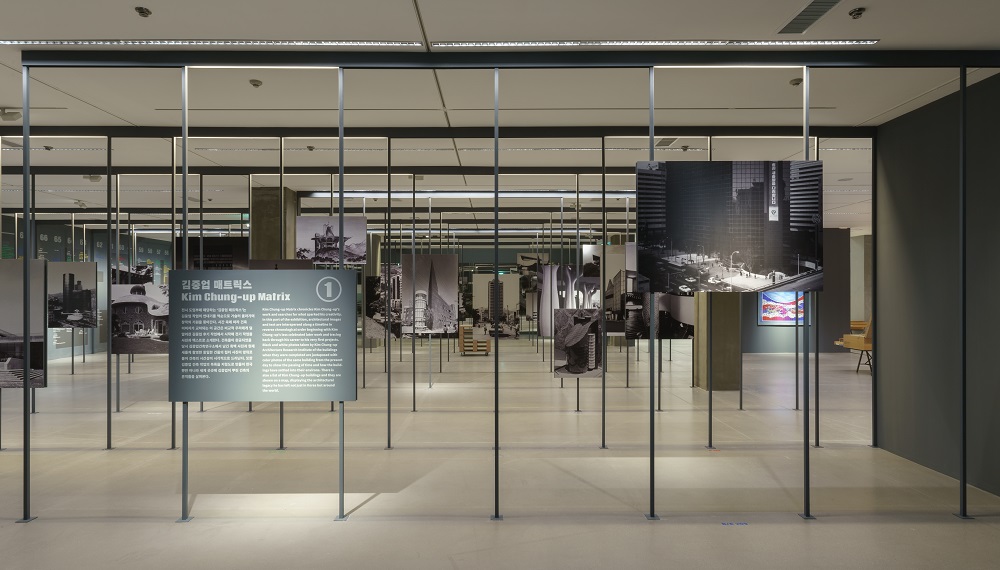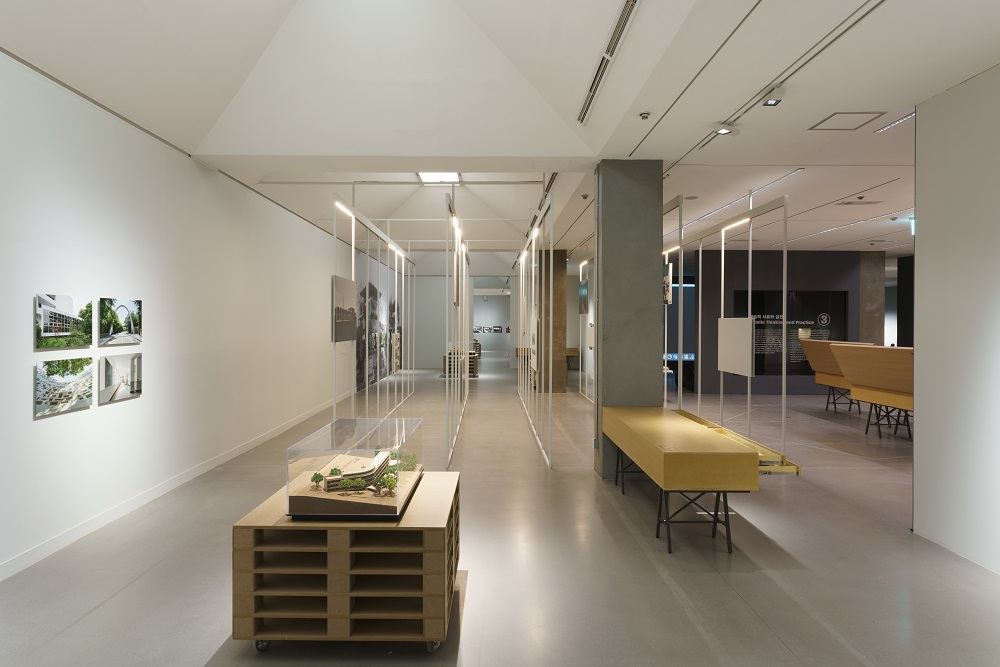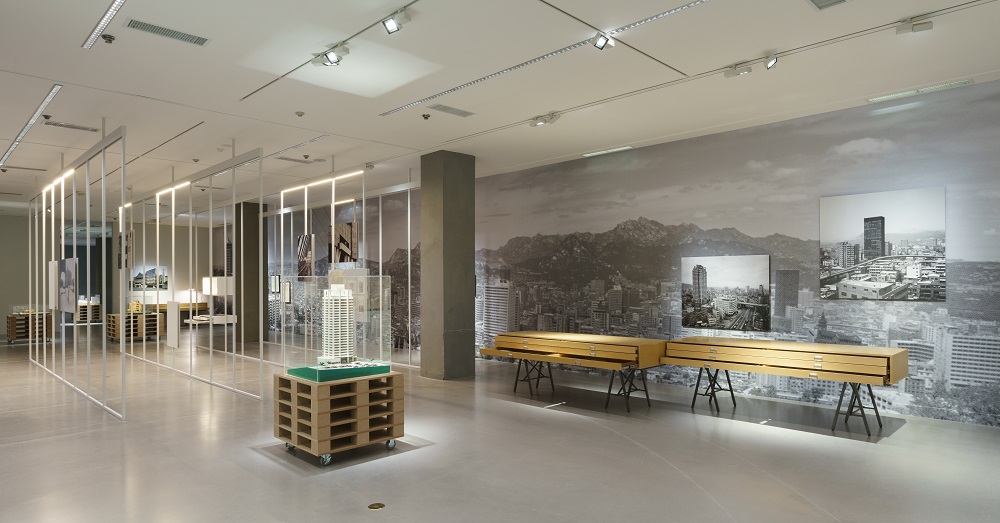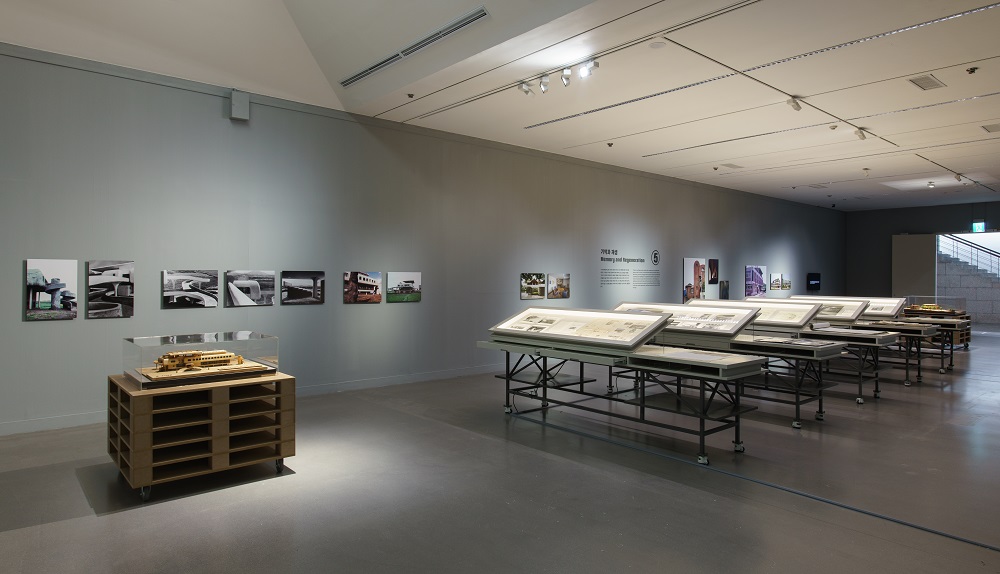[Exhibition Overview]
Kim Chung-up Dialogue is about architect Kim Chung-up, a legendary figure in Korean modern architecture. Keeping a distance from superficial descriptions about him and his almost mythical reputation, the retrospective explores the architect and his legacy in various contexts that have not been discussed before such as the relationship between art and architecture as a medium. It is hosted by MMCA, who have regularly curated exhibitions about Korean modern architecture, in partnership with the Kimchungup Architecture Museum to celebrate the architect on the 30th anniversary of his death. As the first large scale exhibition tracing back Kim Chung-up's life and legacy, it consists of Kimchungup Architecture Museum's collections, MMCA's archive, some materials loaned by owners of buildings the architect designed, and newly commissioned photographic and video works.
Born in 1922 in Pyongyang, Kim Chung-up wanted to realize Korean modern architecture in the after-math of the Korean War after his experience working in the atelier of Le Corbusier. From his position at the center of the Korean arts and cultural community he supported and collaborated with many artists for a long time based on a strong social network he built while living in Busan when it was the temporary capital of Korea during the Korean War. Kim Chung-up was the first architect in Korea who held his own architectural exhibition. In this respect he was an early adopter who understood and practiced exhibition as a cultural format before others.
The first part of the exhibition presents Kim Chung-up's works in reverse chronological order. And then it moves on to explore the context he worked in, which was previously considered peripheral, divided into four themes: globalism and localism; artistic thinking and practice; city and desire; and memory and regeneration. This exhibition pays special attention to examining some of his under-appreciated later works, his collaborations with important artists in Korea, and his thoughts on cities, all of which have not been discussed in depth until now. We hope this exhibition acts as a catalyst to open up discussions about architecture, arts, and diverse social networks in Korean society, and serves as a starting point for the study of the artistic legacies left by Korean architects.
Kim Chung-up Matrix
Kim Chung-up Matrix chronicles Kim Chung-up's work and searches for what sparked his creativity. In this part of the exhibition, architectural images and text are interspersed along a timeline in reverse chronological order beginning with Kim Chung-up's less celebrated later work and tracing back through his career to his very first projects. Black and white photos taken by Kim Chung-up Architecture Research Institute of the buildings when they were completed are juxtaposed with color photos of the same building from the present day to show the passing of time and how the buildings have settled into their environs. There is also a list of Kim Chung-up works and they are shown on a map, displaying the architectural legacy he has left not just in Korea but around the world.
Globalism and Localism
Kim Chung-up introduced the formative language of modern architecture to Korea and he wanted to realize ‘Korean Modernism' through his architecture. The values of globalism and localism co-exist in his buildings. With the École des Beaux-Arts style architectural education he received from Prof. Junpei Nakamura at Yokohama Higher School of Technology (now Yokohama National University) it is natural he came to admire Le Corbusier. Through his experiences in Japan and France he naturally encountered 'modern architecture'. As an architect he utilized the philosophy and style of modernism and he also taught it as a subject, both in Korea and around the world. Meanwhile, he also explored Korean tradition by working as a committee member at the Cultural Properties Management Bureau and contributed to the research for Antechamber of the Seokguram Grotto and the planning for the Gyeongju National Museum. After returning from Paris in 1956 he opened the Kim Chung-up Architecture Research Institute and went on to design the Administration Building of Pusan National University, the Administration Building of Sogang University, and Konkuk University Library. And he created work that represents Korean modern architecture in the form of the French Embassy in Korea.
Artistic Thinking and Practice
Kim Chung-up pursued the idea of the architect as artist throughout his life. This vision lined up with the demands of the era, when Korea wanted to foster its own architects after the Korean War as it lacked technological expertise and the capital to bring in foreign architects. After returning from Paris, Kim Chung-up devoted himself to promoting the concept of the architect as artist through various activities including holding the exhibition Kim Chung-up s Architecture in 1957, the first solo exhibition of an architect in the country, and taking a seat on the judging panels at National Exhibitions. He became an important figure in the arts and cultural community by supporting artists' exhibitions and works through the network with artists he had built in Busan after the liberation of Korea. He actively collaborated with artists through his projects such as the French Embassy in Korea and the Olympic World Peace Gate. Kim Chung-up hoped to combine the arts with architecture by integrating other forms such as sculpture, stained glass, and tapestry into his buildings. In this section you can see the architecture documentary KIM CHUNG UP Architecte about his projects including the French Embassy in Korea, Samil Building, and Tokyu Hotel, which he produced with French filmmakers in 1971.
City and Desire
This section looks at Kim Chung-up s architecture in the context of the city. Up until now Kim Chung-up's work has been interpreted on its own terms, judged on its form like modern sculptures. However, in order to fully comprehend Kim Chung-up's complex and varied later projects it is necessary to understand the development conditions of rapidly growing Korean cities at the time. Many of Kim Chung-up's buildings that required advanced technology and huge capital were in urban areas, such as Samil Building, Tokyu Hotel, Headquarters of Industrial Bank of Korea, and Korea Rehabilitation Agency. During the 1980s he designed cultural infrastructure for regional cities across Korea, which expanded at a rapid rate over that decade. Kim Chung-up also wanted to build useful facilities for people that could not be altered so easily in rapidly changing cities, such as an obstetrics and gynecology clinics, shopping centers, and unique private residences.
Memory and Regeneration
Memory and Regeneration' deals with a broad sense of architectural memory and its revival. In this section we explore the sense of time in Kim Chung-up's work, ranging from his projects built to commemorate something to the buildings he completed that either no longer exist or will be renovated to answer the needs of a new era. Kim Chung-up's buildings, most of which are over 30 years old, act as the starting point for various discussions on memory surrounding architecture, including its life span, urban regeneration, and how we preserve modern cultural heritage.
[Artist]
Born in 1922 in Pyongyang, the capital of what is now North Korea, architect Kim Chung-up had an École des Beaux-Arts style architecture education at Yokohama Higher School of Technology (now Yokohama National University) after graduating from Pyongyang High School. After he completed his studies he started working at the Matsuda & Hirata Design office based in Tokyo, and then returned to Korea and got a job as Assistant Professor for Architecture in the Department of Engineering at Seoul National University. Due to the Korean War, Busan was temporarily made the capital city and Kim Chung-up moved there and built up a strong network of various artists. In 1952 he had the opportunity to travel to Venice, Italy as a Korean delegate for the first International Artist Competition. In Venice he met Le Corbusier and went on to work in Le Corbusier's atelier in Paris for three years and two months from October 1952 to December 1955. On his return to Korea he launched Kim Chung-up Architecture Research Institute in Seoul and went on to design projects including the Administration Building of Pusan National University and the French Embassy in Korea.
While actively working in Korea he was suddenly expelled from the country because he criticized the government policy regarding the 1971 Gyeonggi Gwangju Incident. Samil Building, one of his most renowned projects that was completed just before his expulsion, symbolized the new status of Korea, which had been developing rapidly. After seven years abroad he returned to Seoul and found it was changing dramatically so he concentrated on redefining its architecture by designing glass buildings in the same vein as Samil Building. Amid swift societal change, his work gained an aspect of futurism that differentiated it from his previous projects. Unfortunately, many of his later designs that contained his utopian ideas were not realized and the Olympic World Peace Gate was his last work, completed after his death. Kim Chung-up's family donated most of the material held by Kim Chung-up Architecture Research Institute to Anyang City, which is now home to the Kimchungup Architecture Museum.
[Gallery View]




